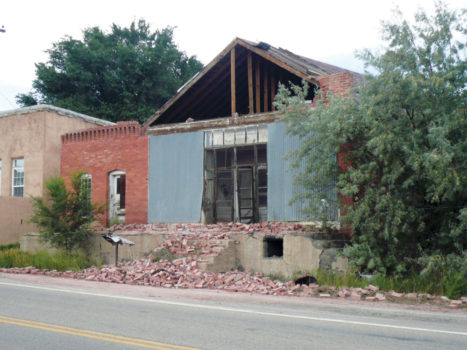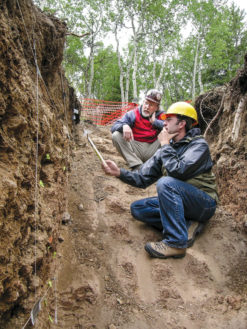
When the earthquake hit, I was in the shower. A quick debate ensued—ought I dress or just dive for cover below the nearest desk? Was Godzilla stomping by my California motel? Nope—but a mere decade later, I was surprised to learn that earthquakes like this are increasingly becoming part of Coloradans’ experience.
That’s because we’re causing earthquakes to happen, and we’re not very prepared for them.
An earthquake is a rapid shaking of the ground that occurs when a fault, or underground crack, moves suddenly. Like tossing a pebble in a pond, underground waves ripple through the ground when the earth lurches, translating energy from the epicenter to distant regions.
These cracks and faults move periodically. Usually they’re triggered by continents pushing against one another or by volcanos rumbling. In Colorado these movements aren’t common, and typically result in small earthquakes. The biggest local hot zones for such activities are in our mountains. There are a few exceptions—like tremors that occasionally stem from gnarly but little-known faults near Commerce City and La Junta. Or the really big quake that hit Estes Park in 1882—it was about the same size as the Northridge quake that devastated Los Angeles in 1994.
But we’ve been steadily raising the stakes in our local earthquake hazard scene. Whether by blowing up underground nukes or stuffing undrinkable water underfoot, we’ve triggered plenty of quakes.

Collapsed front of a brick building (note crushed mailbox) in Segundo, CO, after the 2011 Trinidad, CO earthquake. Photo by Matt Morgan
Is fracking to blame? Hardly. Fracking does cause micro-quakes, but most of these are tiny and can’t be felt.
Is extraction of oil, gas, or groundwater to blame? Not directly. Although sometimes the removal of fluids from the pore space in underground strata causes ground slippage, such movements are generally small and don’t produce many quakes that we can feel.
Triggered quakes mostly result from our injection of fluids into the ground where subsurface faults were unknown to exist. These fluids include: i) wastewater that’s removed from oil-bearing rocks in the process of extracting oil; ii) salty surface waters that we’re trying to keep from contaminating waterways; iii) stinking water removed as a byproduct of extracting natural gas from coal beds; and iv) fracking fluids.
Ironically, we’ve known about this phenomenon for a half century—because the world’s scientific community discovered it right here in Colorado. Back in the 1960s, when earthquakes were suddenly wreaking havoc in Denver, a geologist named David Evans figured out that they were caused by the Army’s injection of chemical weapons waste into the bedrock. The U.S. Geological Survey confirmed this work with some nifty experiments out in a Rangely oil field—directly proving that pumped fluids can cause earthquakes.
The logic is as follows. When we inject waste fluids into the ground, it increases the overall pressure of water that’s already trapped between subsurface layers. This in turn causes a pressure wave, which can travel fairly long distances underground. When the wave encounters a fault, it can destabilize it. Ka-thwam! The fault moves and an earthquake occurs.

Geologists Matt Morgan and Robert Kirkham of the Colorado Geological Survey examine evidence for movement along a fault, after trenching through soils deformed by the fault and mapping their internal structure. Photo by Dave Noe
But there’s a challenge. This fluid pressure chain reaction can trigger faults located tens of miles away from where the waste is injected, often with a time lag that makes it hard to link cause with effect. Some state agencies and academic institutions, in cooperation with our region’s oil and gas companies, have been working to better characterize these systems so we can dispose of these fluids sans earthquakes.
Fortunately, most such “induced” earthquakes are small. But in the last decade the moderate-sized ones have become more common. Witness Oklahoma, which now has more quakes than California. A tiny fraction of these tremors are big enough to disrupt our lives—sometimes toppling furniture, breaking windows, and splitting foundations. See the known faults and quakes in your neighborhood at http://dnrwebcomapg.state.co.us/CGSOnline/.
Although Colorado’s risk for big earthquakes is low, its vulnerability is increasing. In part this is because we’re rapidly expanding our built environment. Yet our building codes and infrastructure aren’t designed to resist quakes as systematically as occurs in quake-prone places like California or Alaska. And, although we might not need to be prepared for “the big one,” there’s greater risk in not being prepared at all for the “most likely one.”
So what can we do? First, think about what might fall onto your head during a middle-of-the-night tremor. Second, consider strapping your gas water heater to the wall. This 10 buck solution will keep your house from burning down should your heater tip over during a quake. And when the quake hits? Drop, cover, and hold on. Maybe skip the selfie.
James Hagadorn, Ph.D., is a scientist at the Denver Museum of Nature & Science. Suggestions and comments are welcome at jwhagadorn@dmns.org.


0 Comments